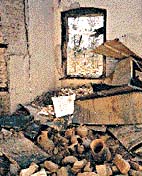
Hier der erste Bericht:
As of September 26, 1996, the museum staff had worked almost six months instead of the one month estimated by the UNESCO mission last summer. The storerooms had been pilfered yet again since Pierre Cambon, Musee Guimet, and the staff had cleaned them in July 1995 in preparation for making a systematic inventory, and the floors were littered anew with potsherds and objects flung randomly in all directions. The staff worked heroically, encouraged daily by Najibullah Popal, Deputy Director of the Kabul Museum. Amidst all the destruction and ruin, it was a hapy surprise to see that 99% of the remaining objects had registration numbers and were intact, albeit fragments. The majority of objects, in fact, were fragments, with very few exceptions. The marble herm from Ai Khanum was found headless, but later the head was uncovered in another store and the figure is now complete. The ivory throne back from Begram was demolished to remove the 13 small carved panels; splinters of the frame were found strewn over the floor. Countless fragments of smashed Greek plaster emblems were swept up from the Begram storeroom.

Der Bericht von Martin Bailey in: The Art Newspaper, Issue 65, December 1996 handelt von der Plünderung und Verwüstung des Musums:
The precious ivory throne-back from Begram was found demolished, after looters had removed the thirteen intricately carved panels. Splinters of the throne were strewn on the floor. Countless fragments of smashed Greek plaster medallions were swept up from the Begram storeroom. Not a single intact object survived from the Begram collection, which had been excavated in the 1930s at the second-century summer palace of the Kushan king. Most of the collection has already passed onto the black market, dispersed to thousands of unscrupulous dealers and collectors abroad. When the loot eventually reaches the connoisseurs, through a series of hands, prices are high. A specialist we spoke to in Islamabad revealed that she had just been shown four first-century Begram plaster medallions from the museum, with an asking price of $150,000.
Vielleicht handelt es sich um die genannten Abgüsse, die im April 1997 von der Organisation SPACH zurückgekauft wurden:
 |
 |
 |
Luke Harding bringt im Guardian, November 17, 2000, ein Resume der Ereignisse:
To their credit, the Soviet troops who invaded Kabul in 1979 took nothing away, even repainting some of the exhibition rooms. But in 1992, three years after they left, the museum found itself on the front line, as rival Afghan Mujaheddin factions fought for control of the city. The museum repeatedly changed hands among different groups, who plundered as they went. By the time the museum staff managed to get access to the building in late 1994, the collection had disappeared. Some of it had been destroyed. But most of it, it later emerged, had been looted in the early days of the fighting. A series of vans had rolled up at night outside the museum's side door. The two-tonne Buddhist reliefs, for example, were lifted off their iron hooks, piled in the back, and hidden under a series of mattresses. They were then driven across the Pakistan border, via the Khyber Pass, to the frontier town of Peshawar, which is the centre of the illegal trade in Afghan antiquities. From there they were sold in Peshawar's many antique bazaars. The buyers included wealthy Japanese collectors, Afghan warlords and Pakistan's home minister. The exhibits, it seemed, had gone for good. But two years ago a London antiques dealer based in Bond Street received a mysterious phone call. A Pakistani businessman wanted to know if he was interested in buying some "newly excavated" figures from Afghanistan. The dealer, who does not want to be named, had a look at photos of the objects. "I recognised them immediately as some of the Begram ivories," he says. The ivories were the museum's star exhibits - a series of exquisite Indian panels nearly 2,000 years old, dug up by French archaeologists in the 1930s from the capital of what was once King Kanishka's flourishing empire. The dealer bought the pieces. Then he donated them to a Paris museum specialising in Asian art, the Guimet. But the best ivories were still missing.